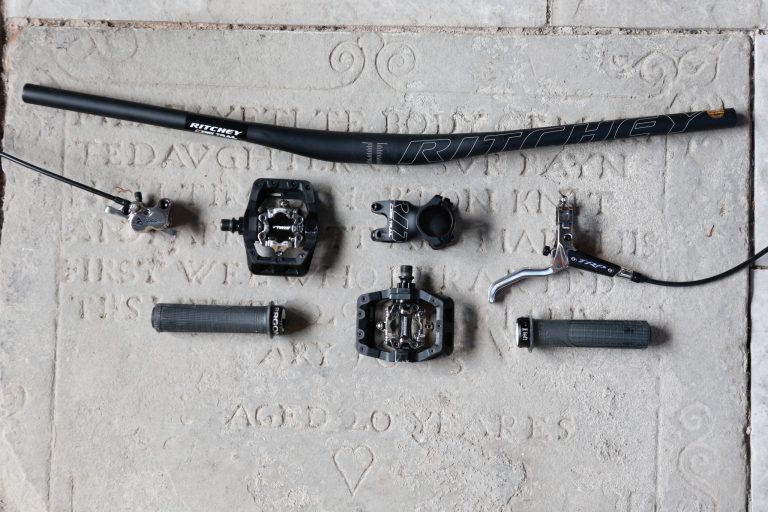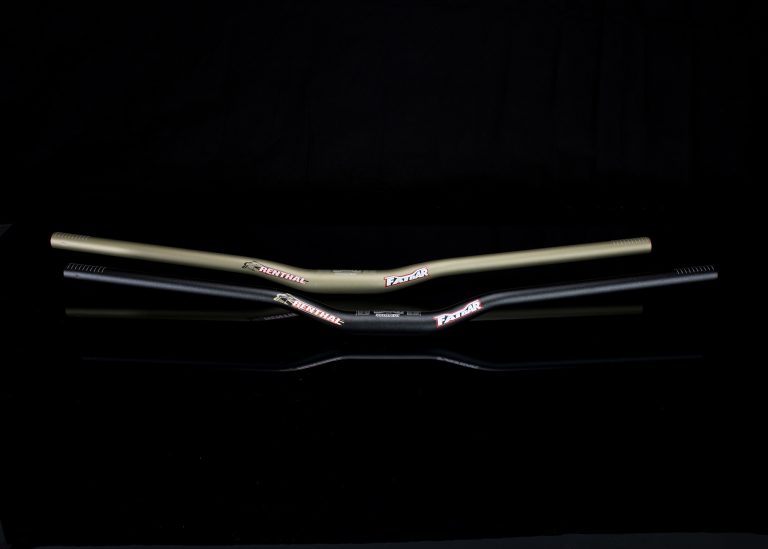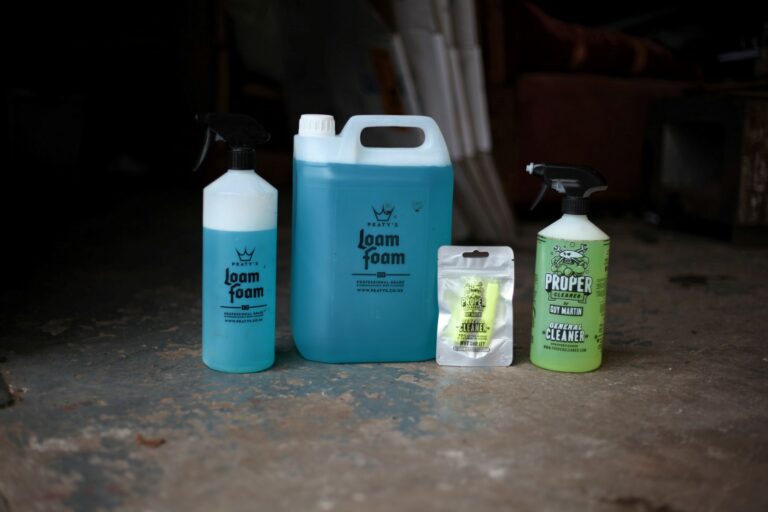HERE WE BLOODY GO THEN
I was surprised in seconds with the liveliness and weightlessness of this bike. This bike has more muscle on the rear than any other I have tried, with no unnecessary fat hanging around in terms of suspension mileage. With a 600lb spring it was aggressively suspended and I instantly liked it.
And I immediately felt comfortable with the size. This is a crucial point I feel with these particular bikes. At 6’ I am at the upper limit of Santa Cruz’s recommendation of the medium sizing. I immediately began thinking what effect two inches more on the front centre might have in terms of riding. I was possibly riding the wrong size on previous occasions. Cosmetically its curves now arc in a more comfortable loop on the top tube than the ‘06 bikes. Balanced, carefully sewn up and a country mile from the original V10 of 2001. Some say it’s a good looking bike, and I suppose if you are one of those riders precious about your bike and…well I don’t even want to go there. On a technical note the mech hanger is now fully integrated yet demountable in a flash from the chainstay. Nice touch. Less weight.
All the rest of the componentry was pretty much production, except that Steve was eagerly awaiting his new RockShox rear shock, something that he is keen to try, not having used one since his first World series win in 2002. The front BoXXer World Cups were standard with all the associated high maintenance issues that goes with them.
What we can focus on then is that it is lighter than before. At under 40lbs with revised frame tubing and lighter drop outs, the only frame parts shared with the existing V10 are the seat and chainstay yokes. More meat has been added in the head tube area however, something that must have been an issue on the previous model.
The second, and most important point, is that it is livelier. This is partly down to the revised linkage rates, now carbon, that enable the bike to sit higher for that skippier ride hitting more tops than bottoms. And with Steve running higher compression than standard on his shocks (even though he says it was actually softer than normal for the test) there was never a problem of the bike being too soft in the first part of its travel. Personally I would have gone down to a 550 on this bike yet on a ‘06 600 is rideable.
 Testing it even in the vaguest sense of the word for the time we had it was a problem. And let’s say the suspension wasn’t particularly at the top of its game. I also had to section the rugged San Remo track to get any kind of idea what Peaty asks of his bike for a full five minutes. It’s strange to ride on such a high bottom bracket (roughly 15”) with more of the travel in sag but the running height seems fine. On the bigger rockier outcrops this inspires a full bore approach. Much more so than an eight inch bike with 13.5” BB. Advantage one. Advantage two is pedalling efficiency. It pedals effortlessly (god some of those six inch bikes sucked compared to this), Willingen with this kind of compression makes total sense (even though Willingen itself doesn’t). And linked to the previous comment so too does the bruising Mt St Anne. Finally it carries its speed exceptionally well. Quite why this is happens to be so however is one of the great unknowns. Is it the suspension linkage?
Testing it even in the vaguest sense of the word for the time we had it was a problem. And let’s say the suspension wasn’t particularly at the top of its game. I also had to section the rugged San Remo track to get any kind of idea what Peaty asks of his bike for a full five minutes. It’s strange to ride on such a high bottom bracket (roughly 15”) with more of the travel in sag but the running height seems fine. On the bigger rockier outcrops this inspires a full bore approach. Much more so than an eight inch bike with 13.5” BB. Advantage one. Advantage two is pedalling efficiency. It pedals effortlessly (god some of those six inch bikes sucked compared to this), Willingen with this kind of compression makes total sense (even though Willingen itself doesn’t). And linked to the previous comment so too does the bruising Mt St Anne. Finally it carries its speed exceptionally well. Quite why this is happens to be so however is one of the great unknowns. Is it the suspension linkage?
Whatever, it’s a very responsive bike, easy to move around but the key point that emerged from this ride was the fine line involved in setting up such a bike. I was very happy with the straight–line stability and aforementioned carrying of speed, but into high-speed deep and downward berms that comprised the lower minute and a half of the track, the fork dived and the rear extends and you have to move back on the bike. With 150 psi and a weary set of BoXXers I had issues and had to up the pressure to move my weight back. I have no problem in doing this, but 165psi is a fair bit more than I would normally use. Some riders may find this an issue, but most racers have found ways to ride around this or incorporate it into their style and make use of the ten inches and the manner in which it carries speed. The bottom bracket also enables you to pedal in places you cannot on other bikes. You only have to watch Peaty race to see this.
Steve Peat asked several times what I would change to the bike to make it suit me. Well I was instantly happier with the size and truly feel what size you are and what size V10 you chose does make a bigger difference than on many other bikes. Much of the time it matters little between a medium and large, on this bike it does. Secondly I would really like to find a compromise between lowering the spring weight front and rear to position me in a lower centre of gravity for cornering, whilst maintaining that charging full blooded straight–line smashing (sorry about the rims Steve). This would take more time. What I learned is that it is quite a highly strung bike, but I know that I am one hell of a lot closer to making it like I want it than the current bike.
You can link this back to what we learned from the visit to Barels place in the last issue, and that is the importance of ratios. In this respect as I’ve said, at 6’ a large is definitely better placed for me simply because it gives me an extra two inches more stability on the front of the bike making it close to a medium Orange. Definitely better placed on the bike. That little bit on the front has had the effect of moving my weight rearwards slightly and the full body workout I felt on the ‘06 medium with similar springs was less of an issue. With more of my weight on the front than other bikes (strangely the opposite to what some people say they encounter) I would concentrate on getting the balance right on the rear. Another advantage of the large is that with the same BB and chainstay as the medium my BB to wheelbase ratio is better. I liked the rear shock even though it had been through it a bit, but personal suspension settings, difficult to describe, even more impossible to prescribe. Compression seemed very progressive yet often presented itself on the hill in a linear manner! Yet that’s the nature of VPP.
CONCLUSION
 Peaty made the conclusion very simple in asking me what would I do to set the bike up like I wanted it. I guess I have been fortunate enough to ride one set up pretty much as I’d like it compression wise. I like the weight, the geometry and the non–surprising slim sag set up. It’s definitely a pile driver at ten and I think its minor weakness is in deep, steep, tight corners, but that is something a good rider will compensate for and an average rider will not notice. It was quite unlike any other V10 I’ve ridden. And that’s a good thing.
Peaty made the conclusion very simple in asking me what would I do to set the bike up like I wanted it. I guess I have been fortunate enough to ride one set up pretty much as I’d like it compression wise. I like the weight, the geometry and the non–surprising slim sag set up. It’s definitely a pile driver at ten and I think its minor weakness is in deep, steep, tight corners, but that is something a good rider will compensate for and an average rider will not notice. It was quite unlike any other V10 I’ve ridden. And that’s a good thing.
I know a lot of people might get a little revved up by this feature. There are others who might question the worth of test on a bike that carries the number one plate. I view it as a fantastic experience, an insight into what works for the fastest racer over many conditions. For me the size was right, the compression right and the balance point can be made right with a bit of tweaking. A very, very personal thing. The bottom line is that it is lighter and carries its speed better than before. Should Santa Cruz make this the 2008 production they will continue to add titles.
Looking for more Steve Peat content?
Steve Peat follows Ratboy Bryce in Windham 2014
The Film Of The Year Reviewed: Won’t Back Down – The Life And Times Of Steve Peat







